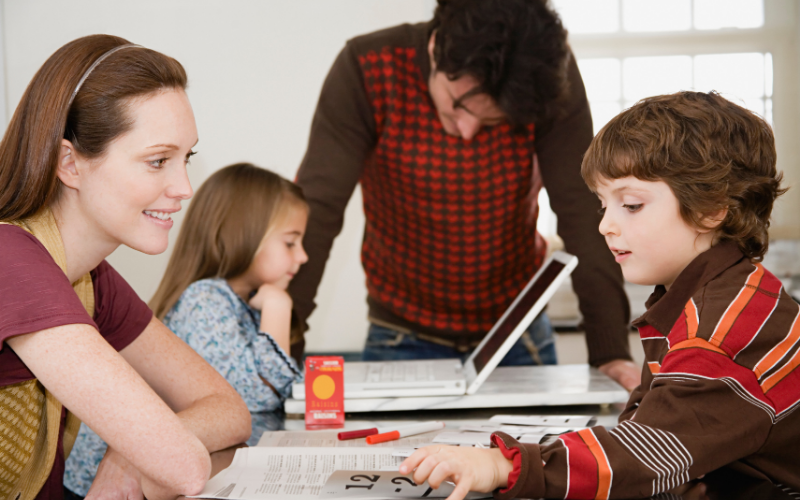Families’ remote learning experience during lockdown more positive than widely believed, but disparities evident based on school type

- As UK parents prepare to homeschool again in lockdown, these US results suggest many parents were satisfied with their experience
- However, most parents felt their child did fall behind
The remote learning experience of parents who had their children at home in Spring 2020, as schools across the US closed during the United States’ COVID-19 lockdown, was more positive than widely believed.
That is the suggestion from a new study published in the Journal of School Choice, which looked at the experience of a nationally representative sample of 1,700 parents stretching right across America.
On average only 44% of parents reported the online learning program required too much of parents, while 38% of parents said it was difficult for them to manage the online provisions.
However, worryingly, most parents (63%) believed remote learning caused their child to fall behind.
While the study focused on 3,414 children’s parents’ experiences, the results revealed to the experts from the University of Colorado, at Colorado Springs, a broad picture of the provision different types of schools offered too.
These findings show more than 80% of schools provided some type of remote learning after closing because of the pandemic. Parents generally rated the programs as effective and the resources as helpful, however most (67%) characterized their engagement as heavily involved daily.
Almost 30% of the time mothers and fathers managed the responsibility equally. Parents spent about 2.5 hours per day helping with schoolwork; children spent about an hour more each day in remote learning.
82% of participants reported their schools eventually developed some type of remote learning. 10% reported schools cancelled classes and provided no remote learning, with the remainder resuming or continuing classes until the end of the school year.
For families in schools cancelling classes and providing no resources, most students (49%) spent their time primarily watching TV and playing games. Only 28% engaged in a learning program created by parents. The remainder worked around the house, worked for pay, or pursued other interests.
Results were not, however, uniform across school type. According to parents, private schools frequently appeared to be the most responsive, engaged, and innovative, followed by charters and then traditional public schools.
Also contrary to predictions throughout summer 2020 about parents’ school choices for Fall 2020, only a small percentage of survey respondents said they were going to homeschool in the new school year. However, more than a third planned to send their child to a virtual school. Of those who were not going to send their children to brick and mortar schools, concern about their child’s health was the dominant and predictable motivation.
“This suggests if there was going to be a significant shift in the education sector, it would be to virtual schools rather than homeschooling,” said the study’s lead author, Dr Dick Carpenter, “and the shift would likely be temporary, assuming COVID-19 is mitigated.”
The study results, although specific only to Spring 2020, provide important information about remote learning in the future.
“Schools rated as most effective were those that more often chose to communicate with students, create real-time, online programs, and set higher expectations,” described Dr Carpenter.
The survey featured 44 mostly closed-ended questions about the resources families had during at-home schooling, how children spent their day, how much time was spent on schoolwork, communication with school, assessment of the experience, plans for the 2021 school year, and basic demographics.
Correspondents were spread across various schools – public (84%), private (10%), and charter (6%).
Hopefully, as remote learning continues in schools internationally, officials can apply these findings “to offer the most effective learning possible to students,” report co-author, Dr Joshua Dunn, also a professor at UCCS, says.
“Despite the better-than-expected experience in the spring, many parents we surveyed were still concerned about their child’s academic future because of school closures. Schools need to apply lessons learned from this study to provide the best and most equitable remote learning possible under circumstances like this,” Dunn concluded.
The majority of survey correspondents were white females. More than 50% held at least a college degree. Slightly more than 60% reported household incomes of greater than $50,000. Additionally, respondents’ mean age was 39 and the mean number of children per respondent was two.
Almost 76% of respondents were married. A little more than half of respondents were working full time when data were collected. The next largest percentage (18%) classified themselves as homemakers. A little more than 60% of their spouses were working full time. Equal percentages of respondents and spouses were working part-time.
With this in mind, the study therefore has a slight limitation with the sample “perhaps skewing more toward women and people who have higher education levels completing the survey,” the authors state.
“Moreover, by necessity, parents were instructed to answer questions thinking of their youngest child in a certain school type. This may result in responses more representative of children in younger grade levels,” they add.

 China
China